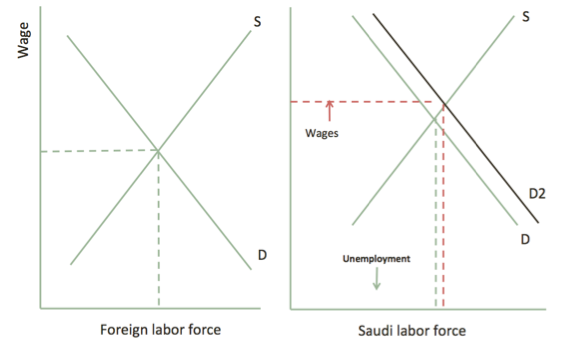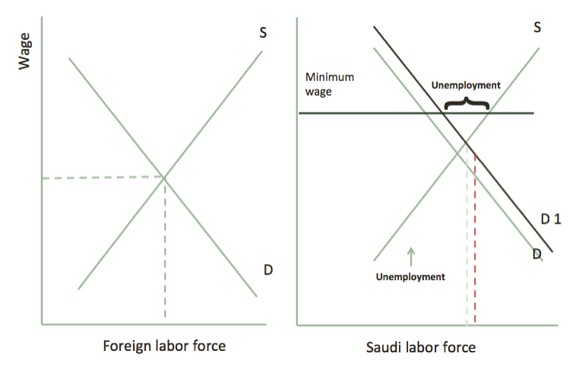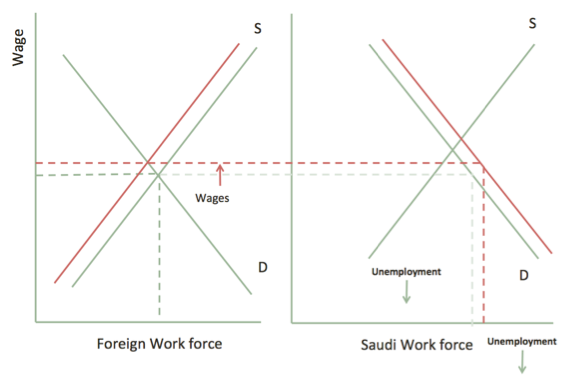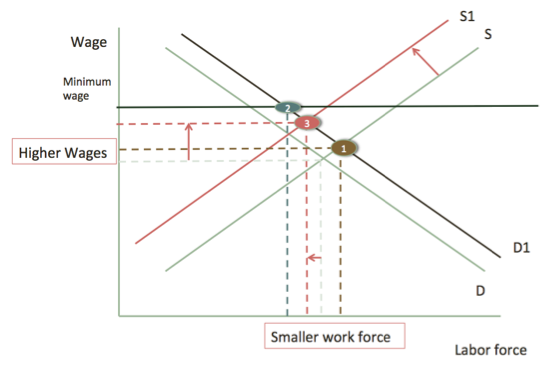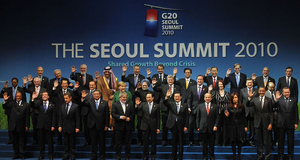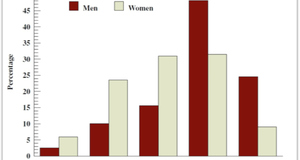The Labor Market in Saudi Arabia: Foreign Workers, Unemployment, and Minimum Wage
By
2014, Vol. 6 No. 06 | pg. 2/2 | « NitaqatNitaqat was a program introduced by the ministry of labor in June 2011; the word Nitaqat means "ranges" or "zones" in Arabic. The program classified all companies into four zones: red, yellow, green, or platinum, according to the percent of Saudis they employed in their companies. Each zone had either privileges or punishments that could lead to closing down the company. Nitaqat caused a big change in the labor market. Most companies were in the red zone; this meant that they didn't meet the required percentages for Saudization and therefore needed more Saudi workers in order to stay in business. This could be represented by a right shift of the demand curve for Saudi workers (Graph 1), which caused both the wage rate and the Saudi labor force to increase, causing unemployment to drop (Saudi Ministry of Labor, 2013).
Minimum Wage in Saudi ArabiaSaudi Arabia had never had a minimum wage, but in September of 2012 the king announced a new one of $800 per month for Saudis working in the public sector, and the private sector also was encouraged to implement the new wage law. In reaction, the minister of labor came out with a new law stating that any Saudi working in the private sector under the minimum wage would not be counted in Nitaqat, and therefore the Saudi worker would not benefit a company by helping them to get out of the red zone. Under this law, all Saudis could now work either at or above the minimum wage (Jebreel, 2012). The minimum wage made more Saudis want to work. With the demand for more workers due to Nitaqat, more Saudis found jobs, except for females, who were at a disadvantage because they had a lower market clearing wage rate and resultant larger unemployment gap, as we have illustrated before.
Deportation LawsOne of the most widely talked about issues is deportation, since it touches the lives of so many people. From November of 2012 to the present time, more than one million expatriates have been deported due to new laws. Under these new laws all workers must work only under their sponsor, and any found working for a different company must be deported. Every worker is required to get a work permit for an annual fee of $650, with the proceeds going to the Saudi Human Resources Development Fund, which focuses on training Saudis to be better equipped to enter the labor market. It is important to say that some of these laws were already in place but were not as strict and were not enforced properly. To enforce the new laws, the Ministry of Labor teamed up with the Ministry of Interior in addition to employing 1,000 inspectors. New government fines and jail terms were given to Saudis who did not comply with the laws which dealt with the organization of labor. As a result of all these measures, the supply of foreign labor shrank by about 20%; this supply shock caused wages to rise, and a substitution effect occurred by which the demand for Saudi workers rose. This is illustrated by the following graph(Fakieh, 2013).
In summing up all the effects, we believe that these policies caused both the wage rate to go up and the work force to shrink.
This is consistent with a survey published in 2011 by Hay Group, an American human resource consulting group. Their study concluded that the average guaranteed cash package for Saudis has increased 7.5% (Al-Salloum & Bin Zarah, 2012). Impacts on ProductivityFrom the above analysis, we find that overall we have higher wages for both the Saudi and the non-Saudi labor forces. We also have a smaller labor force because of the deportation that has occurred over the past two years. At the same time, highly paid unskilled Saudis are entering the labor force, which may prove a burden to the private sector. Consequently, the government should be aware of the risk of lower productivity in the private sector; this could have an adverse effect on the people's income and could potentially add supply-side inflation to general price levels in Saudi Arabia. Moreover, in the long run wages could go back down as productivity decreases, should companies shrink their operations to work with the higher overhead caused by Saudization. This is clarified in the following graph.
ConclusionIt appears as if the new labor laws introduced into the Saudi labor market over the past two to three years were effective in lowering general unemployment in Saudi Arabia. Wages increased for both Saudi and non-Saudi workers, however there is a risk that this wage increase could negatively impact productivity. ReferencesAl-Salloum, G., & Bin Zarah, B. (2012). Labor and the Nitaqat Program: Effect on Saudi Economy. Retrieved from shc.com.sa: shc.com.sa/en/PDF/RESEARCH/Labor and the Nitaqat Program.pdf Alshaii, K. (2010, October 18). Adel Fakieh New Minister of Labor. Retrieved from alarabiya.net: http://www.alarabiya.net/articles/2010/08/18/117025.html Borjas, G. (2004). Increasing the supply of labor through immigration. Retrieved from cis.org: www.cis.org/sites/cis.org/files/articles/2004/back504.pdf Central Department of Statistics. (2013). Labour Force Survey. Riyadh: Central Department of Statistics & Information. Retrieved from http://www.cdsi.gov.sa/dmdoc/manpower201302/ Fakieh, A. (2013, December). Lekaa Aljoma. (A. Almudafir, Interviewer) Retrieved from www.cis.org/sites/cis.org/files/articles/2004/back504.pdf International Monetary Fund. (2012). Saudi Arabia: Selected Issues. Retrieved from imf.org: www.imf.org/external/pubs/ft/scr/2012/cr12272.pdf Jebreel, A. (2012, September 8). Ministry of Labor makes the minimum wage SR 3,000. AlEqtisadiah(6907). Retrieved from http://www.aleqt.com/2012/09/08/article_690815.html Krugman, P., Obstfeld, M., & Melitz, M. (2012). International Economics. Boston, MA: Pearson. Saudi Ministry of Labor. (2012). Annual Statistics Report. Riyadh: Saudi Ministry of Labor. Retrieved from www.emol.gov.sa/nitaqat/files/manual.pdf Saudi Ministry of Labor. (2013). Nitaqat Manual. Retrieved May 7, 2014, from Ministry of Labor: http://www.emol.gov.sa/nitaqat/files/manual.pdf The World Factbook. (2013). Saudi Arabia. Retrieved March 28, 2014, from CIA: https://www.cia.gov/library/publications/the-world-factbook/geos/sa.html Suggested Reading from Inquiries Journal
Inquiries Journal provides undergraduate and graduate students around the world a platform for the wide dissemination of academic work over a range of core disciplines. Representing the work of students from hundreds of institutions around the globe, Inquiries Journal's large database of academic articles is completely free. Learn more | Blog | Submit Latest in Economics |

